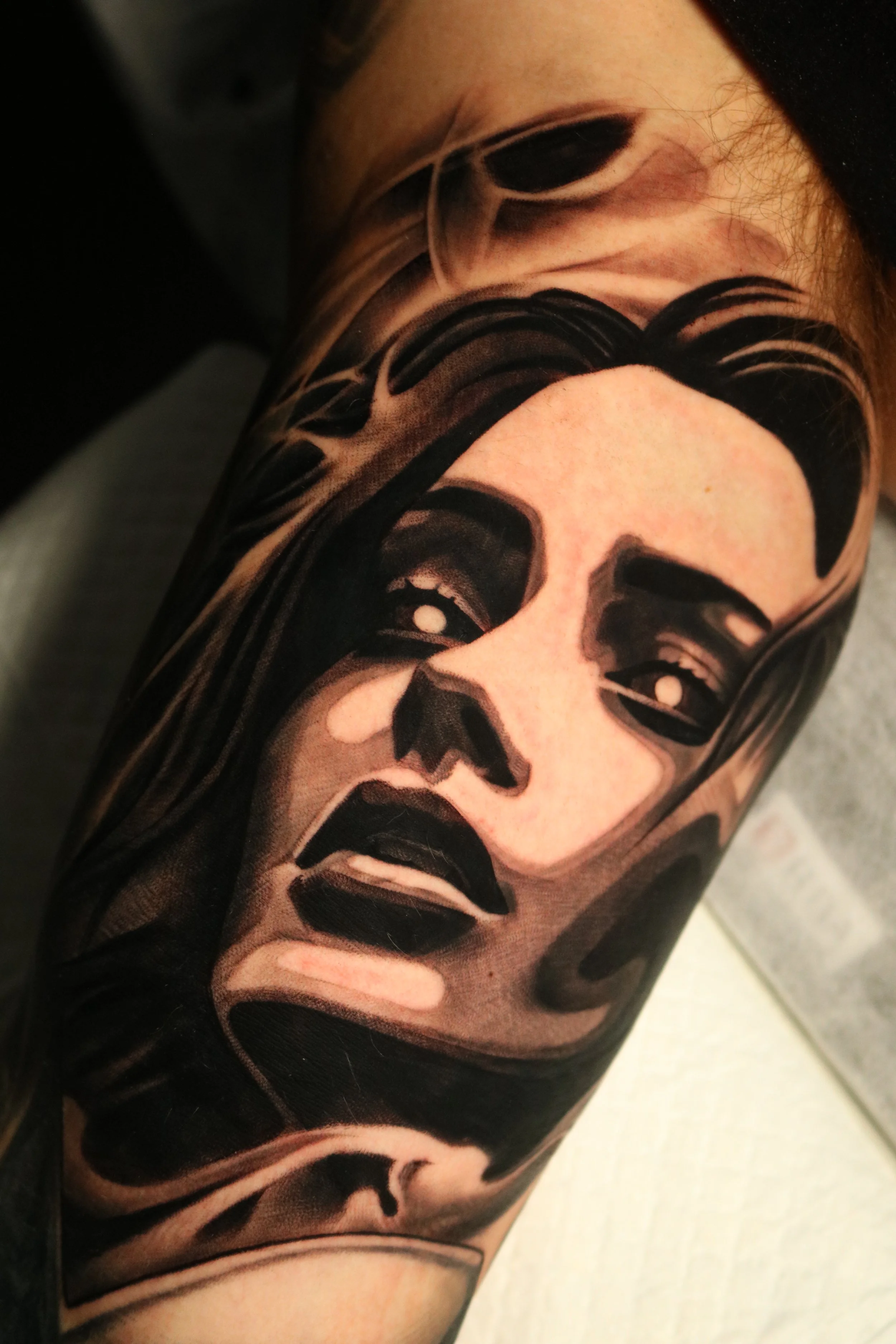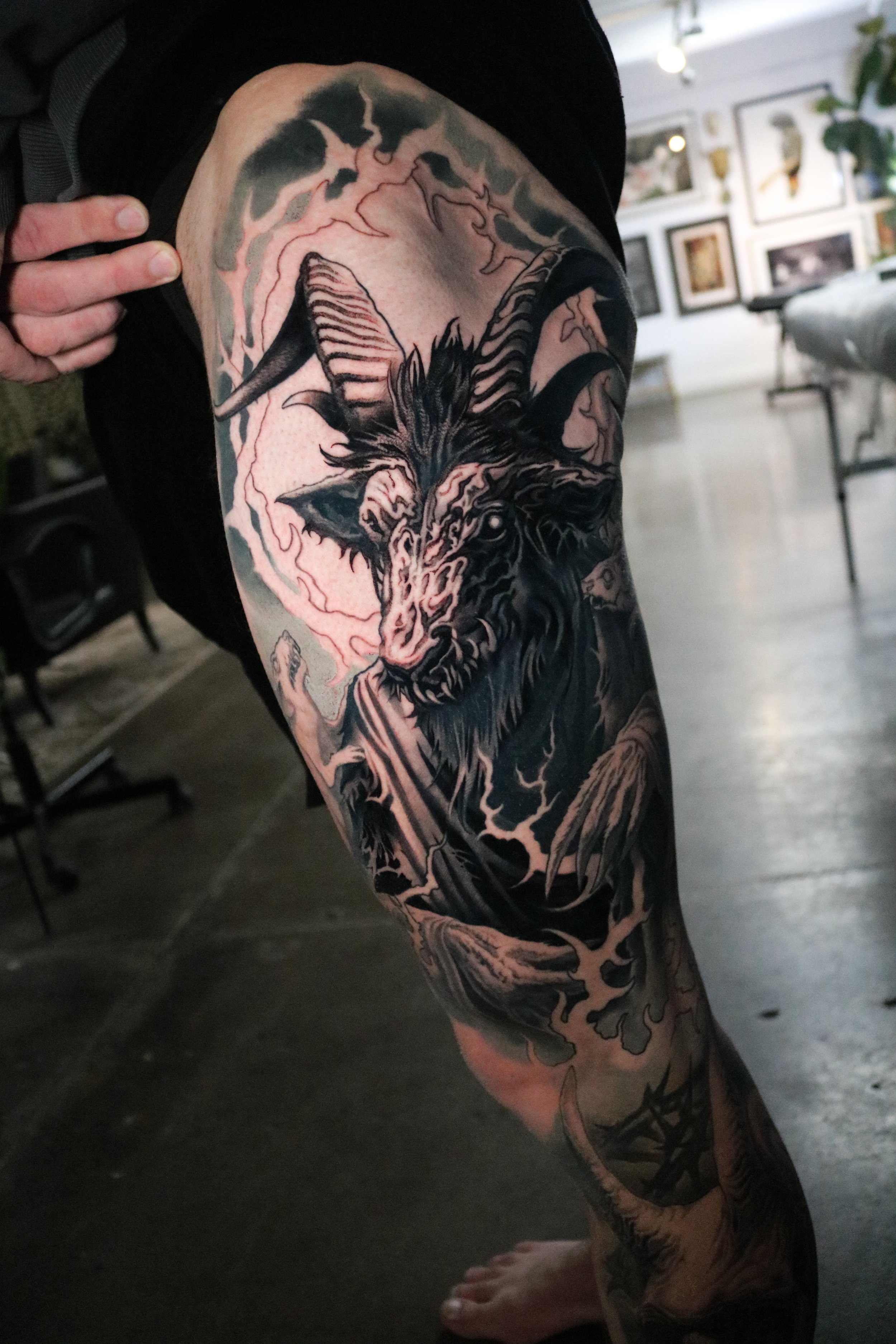
ILLUSTRATIVE
In the ever-evolving world of body art, tattoo styles have flourished and diversified, reflecting individual creativity, cultural influences, and technological advancements. Among these styles, illustrative tattoos have gained significant popularity, captivating both artists and enthusiasts with their ability to tell intricate stories through detailed designs. In this guide, we will explore the history of illustrative tattoos, their rise in popularity, and why they have become a sought-after style in tattoo parlours and shops, particularly in Melbourne.
The Origins of Illustrative Style Tattoos
Illustrative style tattoos draw inspiration from a variety of artistic disciplines, blending elements of traditional tattooing with the techniques and aesthetics of illustration. The roots of this style can be traced back to the early days of tattooing, where artists began to experiment with more complex and detailed designs, moving beyond the simple and bold lines of traditional tattoos.
One of the key influences on illustrative tattoos is the art of engraving and printmaking. These techniques, which have been used for centuries to create intricate images on paper and other surfaces, provided a foundation for the detailed line work that characterises illustrative tattoos today. Artists began to incorporate fine lines, shading, and cross-hatching into their tattoo designs, creating a visual effect similar to that of an engraved illustration.
The development of modern tattoo machines and ink technology also played a crucial role in the evolution of illustrative tattoos. With the ability to create finer lines and more precise shading, tattoo artists could push the boundaries of what was possible, bringing a new level of detail and realism to their work. This technological advancement allowed for the creation of tattoos that were not only bold and striking but also nuanced and expressive.
In recent years, Melbourne has become a hub for tattoo artistry, with a growing number of tattoo parlours and shops offering a wide range of styles to suit every taste. Among these, illustrative tattoos have emerged as a popular choice for both tattoo artists and clients.
One reason for the popularity of illustrative tattoos in Melbourne is the city's vibrant and diverse art scene. Melbourne is home to numerous galleries, art schools, and creative communities, fostering an environment where artistic expression is highly valued. This cultural backdrop has influenced the city's tattoo industry, encouraging artists to experiment with new styles and techniques, including illustrative tattoos.
Additionally, Melbourne's tattoo culture is known for its emphasis on quality and craftsmanship. Clients in the city are often looking for tattoos that are not only aesthetically pleasing but also meaningful and unique. Illustrative tattoos, with their ability to tell a story through intricate and detailed designs, are perfectly suited to meet this demand.
The versatility of illustrative tattoos is another factor contributing to their popularity in Melbourne. Whether it's a black and grey portrait, a colourful nature scene, or a stylised interpretation of a favourite literary character, illustrative tattoos can be adapted to suit a wide range of themes and personal preferences. This flexibility makes them an appealing option for clients seeking a tattoo that is truly one-of-a-kind.
The Popularity of Illustrative Tattoos in Melbourne
The Influence of Art Movements
Illustrative tattoos are deeply influenced by various art movements, particularly those that emphasise line work, detail, and storytelling. The Art Nouveau movement, which emerged in the late 19th century, is one such influence. Characterised by its flowing lines, organic shapes, and intricate patterns, Art Nouveau has inspired countless tattoo artists to incorporate similar elements into their designs.
Similarly, the Art Deco movement of the early 20th century, with its geometric patterns and bold lines, has left its mark on illustrative tattoos. These artistic influences, combined with the growing appreciation for fine art in the tattoo world, have led to the development of a style that is both visually striking and rich in detail.
The impact of contemporary illustration, graphic design, and even comic book art can also be seen in illustrative tattoos. The rise of these visual art forms in popular culture has led to a cross-pollination of ideas and techniques, further blurring the lines between traditional tattooing and illustration.
Key Elements of Illustrative Tattoos
To understand the appeal of illustrative tattoos, it's essential to explore the key elements that define this style. At its core, illustrative tattooing is characterised by detailed line work, shading, and a strong emphasis on composition. These elements come together to create tattoos that are not only visually striking but also convey a sense of depth and movement.
1. Line Work
Line work is the foundation of any illustrative tattoo. The use of fine lines, varying in thickness and texture, allows artists to create intricate designs that mimic the look of an illustration. The precision and skill required to execute clean and consistent line work make this style particularly challenging but also highly rewarding.
In illustrative tattoos, line work is often used to define the outlines of the design, as well as to add texture and detail. Artists may employ techniques such as cross-hatching, stippling, and line shading to achieve different effects, from soft and subtle gradients to bold and dramatic contrasts.
2. Shading and Colour
Shading plays a crucial role in bringing an illustrative tattoo to life. By adding depth and dimension through careful shading, artists can create the illusion of three-dimensionality, making the design appear more realistic and dynamic. In some cases, shading is done using only black ink, while in others, artists may incorporate colour to enhance the visual impact of the tattoo.
The choice of colour in illustrative tattoos is highly subjective and can range from muted, monochromatic palettes to vibrant, eye-catching hues. The use of colour can help to highlight specific elements of the design, create contrast, or evoke a particular mood or atmosphere.
3. Composition
Composition is another essential aspect of illustrative tattoos. A well-composed tattoo takes into account the shape and contours of the body, ensuring that the design flows naturally and complements the client's anatomy. This consideration is particularly important in large-scale illustrative tattoos, where the placement of the design can significantly impact its overall effect.
Artists often spend considerable time planning the composition of an illustrative tattoo, sketching out different ideas and adjusting the design to fit the client's body. This attention to detail is one of the reasons why illustrative tattoos are so highly regarded in the tattoo community.
Why Choose an Illustrative Tattoo?
For those considering getting an illustrative tattoo, there are several compelling reasons to choose this style. Firstly, illustrative tattoos offer a level of detail and complexity that is difficult to achieve with other styles. This makes them ideal for clients who are looking for a tattoo that is not only visually impressive but also rich in meaning and symbolism.
Secondly, illustrative tattoos are highly customisable. Because they draw on a wide range of artistic influences and techniques, they can be tailored to suit the client's individual tastes and preferences. Whether you want a tattoo that is bold and graphic, soft and painterly, or something in between, an illustrative tattoo can be designed to meet your needs.
Finally, illustrative tattoos have a timeless quality that ensures they will remain visually appealing for years to come. Unlike some trends that may fade in popularity over time, the classic elements of illustration—line work, shading, and composition—are likely to remain relevant in the tattoo world for the foreseeable future.
why choose compendium
At Compendium Tattoo, illustrative tattooer Ricky Brookfield brings a unique blend of styles to the forefront, expertly merging abstract black work with realism. Ricky's mastery of heavy contrast in figures and portraits showcases his ability to redefine the boundaries of realism, particularly through his bold line work and impeccable blending skills. His approach to neo-traditional styles, especially in his naturalistic tattoos, highlights his skill in creating dynamic interplay between light and dark.
Ricky’s detailed tattoos of Greek Gods and female portraits are prime examples of his expertise in contrast, where each piece comes to life with deep shadows and striking line work. As a versatile artist, Ricky delves into various genres, including Neo-Trad, incorporating still lives, florals, and animals into his naturalistic tattoos. This diversity allows him to seamlessly blend traditional techniques with modern elements, resulting in a rich and varied portfolio.
Located in Melbourne, Compendium Tattoo stands out as a premier tattoo parlour for those seeking innovative and high-quality illustrative tattoos. Ricky’s commitment to pushing artistic boundaries and setting new standards for creativity and technical excellence makes Compendium Tattoo the ideal choice for your next tattoo. Whether you're looking for a tattoo shop that specialises in line work or one that offers a broad range of styles, Compendium Tattoo in Melbourne has the expertise and artistic vision to bring your ideas to life.






